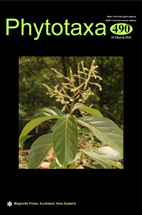Abstract
Two new species and one new nothospecies of Tacinga from semi-arid Eastern Brazil are described. The new taxa were discovered on the basis of material collected during field trips carried out by staff of the Cactarium Guimarães Duque of the Instituto Nacional do Semiárido. A morphologic comparison of all the Tacinga species currently known, together with the cytogenetic analysis of the new taxa, are made. Full descriptions, illustrations, taxonomic discussions for all three new taxa are given as well as an identification key for all known Tacinga species. IUCN categories for the new taxa were assessed, resulting as endangered or critically endangered, due to their small population size and restricted distribution.

